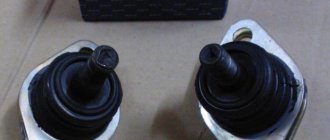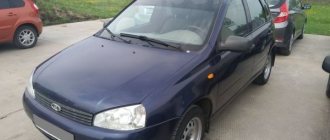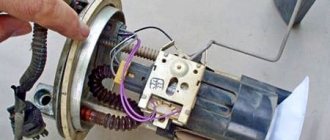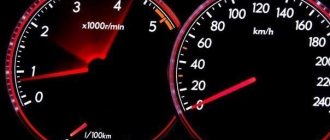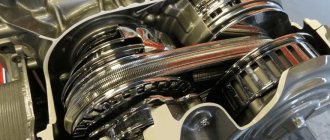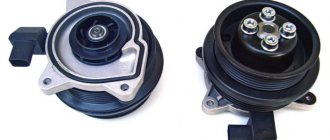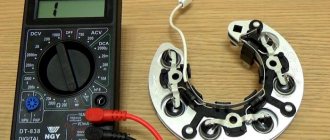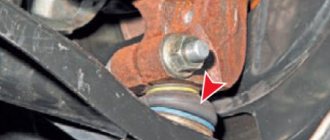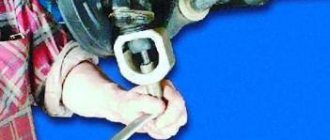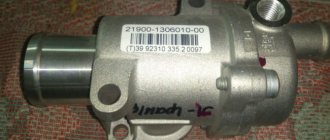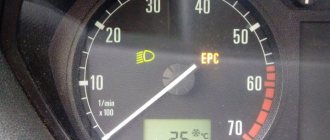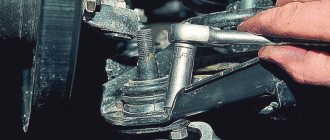Wear of suspension elements is usually characterized by the appearance of a knocking sound in the front of the car when driving over small uneven surfaces. It is difficult for an inexperienced motorist to determine by the sound which part has “gone bad” and requires replacement. But you can diagnose the problem yourself if you figure out how to check the ball joint. After all, it is its breakdown that leads to the wheel coming off and an inevitable accident. The wear of other elements - stabilizer seals, silent blocks and bearings is not so critical and allows you to operate the car for some time.
How does a ball joint work?
At the base of the constant velocity joint there is a pin with a ball on the edge, tightly rolled into the support body. Between the finger ball and the body there is a Teflon gasket and a special lubricant.
On the top side of the steering rod there is a rolling, the purpose of which is to secure the ball rod in the casing, and on top of it is a boot that prevents lubricant from leaking and prevents grinding components from getting in.
What to do if the ball is faulty?
If the ball joint “died”, do not rush to throw it away; its price is often quite high, especially for “business” and “premium class” cars. Therefore, it is not surprising that these elements have been learned to be restored and restored. If restoration is impossible, you cannot avoid completely replacing the unit. The procedure is not complicated and is quite often performed in a garage, so do not rush to look for a suitable service station and overpay for something that you can try to do yourself.
I will end here, I hope you have received a comprehensive answer to the question of what a ball joint is and what it is needed for. In addition, now you know how to check the ball joint in different ways, as well as identify its malfunction. Share this article, if, of course, you liked it, with your friends on social networks, in this way you will contribute to the development of our project. We appreciate every repost and are grateful to each of you! Let good people read good articles!
How to check a ball joint video
Source
Ball joint diagnostics
The main signs of a failed ball joint are:
- Increased steering effort;
- Clicking sounds in the suspension and the car moving sideways when you press the brakes;
- Violation of camber and toe values. This leads to equal wear on one side of the tire;
- Wheel runout on the side, which initiates tire wear. In this case, the tire wears out unevenly, as if in shreds;
- A peculiar knocking sound that occurs when turning the car. In specific cases, noticeable wobble of the steering column may appear.
Before making repairs, you should first make sure that you need to change the steering rod. This can save a lot of time and money.
Signs of ball failure
There are several main signs that will help us suspect problems with support:
- Extraneous knocking in the wheel apron area, which occurs when overcoming road obstacles, especially when speeding.
- The car drifts in different directions when moving in a straight line.
- Creaking sound when turning the steering wheel.
- Increased wear of the tire where the damaged part is located.
If at least one of the problem points is noticed, then checking the suspension parts is mandatory. In addition, it is better to do this in advance to avoid unnecessary expenses for repairs and to protect yourself.
Why does the ball start to knock (make noise)
The root of the dysfunction of the ball joint is the development of the polymer insert. Due to rubbing between the insert and the ball, a backlash occurs, which contributes to the rapid and complete breakdown of the polymer.
Moving with loads, the ball slowly distorts the hole in the body, which often ends with the pin being pulled out of its groove. When the impermeability of the plastic boot is broken, this leads to early destruction of the polymer insert.
The penetration of liquids affects the washing away of the lubricant and the coating of the finger with rust. Particles of dust or dirt from the road increase wear, acting like sandpaper.
Unnatural noises heard when driving over road obstacles indicate problems with the steering supports.
Car owners are interested in how to find out the condition of the ball joint without using a lift and overpass? You can do the inspection yourself by doing the following:
- Park and secure the vehicle on an area with a hard surface.
- The car is raised using a jack and the wheel is removed.
- An extension made of wood or metal is placed under the lever located below.
- The car is lowered.
Such procedures are required to compress the suspension spring. By manually moving the axle from the top down, you can easily find out whether or not there is play in the steering rod. It is worth inspecting the boot to find out its integrity.
When the rubber boot is torn, it is recommended to change the support in the kit, because a small penetration of dirt, as well as sand, greatly reduces the service life of the ball bearing.
Ways to extend service life
In order not to stretch the material, in the article “Ball Joint Life” I described in detail working methods for increasing the life of this part.
The most vulnerable part is the boot, so to extend the service life the most attention is paid to it. Experts recommend inspecting it more often, especially when driving in difficult conditions. At the slightest sign of damage, replace it. Replacing the boot is much easier and cheaper than replacing the entire ball joint.
In serviced hinge models, to add lubricant, the product is provided with a threaded hole into which a grease fitting is screwed. A special syringe is used to add oil. For ease of maintenance, all work is carried out on a lift or inspection pit.
The amount of lubricant should not be excessive, otherwise the protective casing of the support may rupture. 2-3 pumps of the syringe handle are enough. Any substance can be used, but it is better to choose a water-repellent, heat-resistant, CV joint type.
In the case of a maintenance-free hinge mechanism, lack of special lubricant, syringe press, you can delay the replacement of the unit using regular motor oil . To do this, it is drawn into a plastic medical syringe with a needle, the rubber of the cap is pierced and 2-3 cubes are injected. The measure is temporary, but allows you to operate the vehicle until it is fully repaired at a service station.
For other ways to extend the life of ball joints, read this manual. This applies to supports and steering tips. Any of the presented methods can be implemented independently in the garage.
Diagnostics of a ball joint at home (instructions)
It is not difficult to find out the condition of the ball support on a platform or pit. The weight of the vehicle in a compressed state presses on the suspension springs. It is enough to insert the pry bar between the pin and the lever, making several rhythmic movements.
- If play is detected at the finger, then there is a breakdown at the support. It is difficult to see play in the perpendicular plane when the spring is decompressed, especially on massive jeeps, which often accommodate a suspension with many levers.
- When diagnosing on a car lift, you need to press the spring with hydraulics placed under the lever at the bottom and use a crowbar to determine the malfunction of the unit. To identify the state of the ball rod removed from the car, just turn it to the side.
When in this position the apical edge of the finger goes down under its own weight, then the working life of the support is almost exhausted and play will soon arise. It is recommended to replace this support immediately.
Dismountable supports have long ceased to be relevant, even if you received a Moskvich or a VAZ from your relatives, you cannot find spare parts for them to repair the ball joint. It will be easier to install modern units that cannot be disassembled.
What you need for self-check
In situations where a specialized service center is unavailable for some reason, it is advisable to know how you can independently check the ball joints on your car.
To do this you will need the following:
- lift or inspection hole. At worst, you can do without them, but this will seriously complicate the examination;
- jack. It is necessary when it is not possible to use a lift;
- mount. The flat end of such a tool should easily fit into the space between the pivot pin and the ball joint;
- reliable support. Its size should be such that the support can be easily installed in the space between the lower point of the support body and the floor;
- set of wrenches. Their type and size are selected taking into account the design of the unit;
- ball joint remover. Its type depends on the car model.
On the Internet you can find information with direct instructions on what size wrenches and types of pullers should be. Sometimes this information misleads people. The size and nature of fasteners may differ even for parts installed on cars of the same model. It all depends on the specific manufacturer of the spare part.
Carefully!
Carrying out work if the car is parked on soft ground is useless and unsafe. Diagnostics are carried out on a hard surface.
Algorithm of actions from A to Z (master’s recommendation)
To find out the condition of the ball joints, you need to do the procedures in this order:
- The unit is inspected. Violation of the surface of the boot indicates that the element will need to be replaced. To save money, you can stop at replacing the boot. However, such a repair rarely gives good results, because dust that gets into the middle of the hinge will have a bad effect on its integrity. When no superficial symptoms are noticed, then you can move on.
- Using a lift or jack, the car is raised and a previously prepared support is placed under the support body. It is optimal to use a height-adjustable tripod. Then the vehicle gradually lowers down, pressing on the ball bearing. The wheel here ends up in the air and is able to spin without interference.
- Grasping the top and bottom of the wheel, it is allowed to wobble vertically. It’s good when the assistant here begins to turn the steering wheel carefully and smoothly. It will be possible to notice wear only in a separate wheel location. Having seen the backlash, there is no need to come to hasty conclusions. Perhaps it arose due to a breakdown or insufficient screwing of the bearing on the hub, a violation of the silent blocks of the lever, or other errors. The check is ongoing.
- Having installed the flattened edge of the mount into the hole between the pivot pin and the lever, you should press the handle and observe the components of the support. When the part is not broken, there will be no play. Clicks or knocking sounds when pressing on the mount handle also indicate a malfunction of the device.
Signs of failure, causes of wear
The most vulnerable part of the mechanism is the protective boot . Under the influence of aggressive substances on the road: dirt, snow, a mixture of salt and sand, rubber loses its elasticity, becomes deformed, and breaks. Dirt, sand, and moisture get packed inside. They act as an abrasive. Due to constant movement, the tightly pressed surfaces of the polyurethane inserts are erased.
Water washes away the lubricant, the friction force of “dry” surfaces increases, and the wear process accelerates. A significant gap appears between the ball and the liners. If you take a new ball joint, it takes a significant force to move the rod slightly by hand, but in a faulty one it dangles freely. Damage to the protection is the main reason for the reduction in the functionality of the unit and its service life.
Signs of a malfunction are deviation from the straight trajectory of the car when you let go of the steering wheel, squeaks, knocks, especially when driving on broken asphalt. Having started unnoticed, the signs of a ball joint malfunction become more and more apparent.
If you don’t pay attention to them for a long time, your finger may simply be torn out of the base, the wheel will turn upside down, and the car will lose control. In addition to deformation of the body elements in the front part, the car may end up off the road or, even worse, in the oncoming lane.
External signs of malfunction:
- significantly increased effort when turning the steering wheel, squeaks when cornering, knocking noises when overcoming bumps;
- when the steering wheel is stationary, the car constantly deviates to the right, to the left from a straight path - this is a consequence of the increased gap between the ball and the liners;
- A non-obvious sign of a malfunction is uneven wear of the tires. The phenomenon is also observed due to violation of camber angles and wheel toe.
If these symptoms appear, the ball joint must be replaced. The consequences of ignoring these phenomena can be dire.
Reasons for reducing service life:
- Aging, cracks, ruptures of the protection (boot) are the main reason.
- Natural mechanical abrasion of plastic seals. The service life of the unit depends on the quality of the manufacturing material. On domestically produced cars it is within the range of 20-40 thousand km, on foreign new models - 100-150 thousand km.
- Condition of the road surface. Off-road travel, depressions on the surface, and potholes reduce the service life of the vehicle as a whole. When hitting an obstacle at high speed, the unit experiences a powerful shock. A series of such impacts destroys it faster than gradual friction.
- Insufficient lubricant. During assembly, manufacturers provide the bare minimum. By adding additional grease before installation, we extend the service life of the hinges.
Options for determining the condition of the ball joint
It is possible to find out what the condition of the ball is in two ways. You can visually determine the continuity of the boot, and if there are cracks or irregularities in it, replace it with a newer product.
- It is also possible to drive a car onto a platform or pit, and there, due to mechanical manipulations, violations are determined.
- To do this using the mechanical method, you will need to get under the vehicle and pull the wheel with your hands several times to feel the presence of play.
- You can take a crowbar, then put it between the lever and the support, and then try to push it upward.
The use of iron is the most effective way to determine backlash. Another method is to remove the balls, clamp them in a vice, and then check the play of the pin and axle.
When the finger moves with ease, then changing the ball in the kit is really necessary. Experienced drivers can make the replacement, but those new to this business are advised to go to a service station, where all the conditions and experienced specialists are available.
Ball Hyundai Accent: part number and do-it-yourself replacement
Changing the ball joint of a Hyundai Accent without any particular difficulties, if there is no damage to the silent blocks of the lever. The problem may arise when you remove the ball housing from the hole in the lever. All work can be done in various ways. Some motorists remove the entire hub, but this is fraught with consequences - the wheel camber needs to be adjusted. The hub is displaced from the rack; it is unlikely to be installed in its original position.
- Tools and accessories
- Carrying out repairs
Tools and accessories
To replace the boot or the entire ball joint on a Hyundai Accent, you will need the following tool:
- Set of keys and sockets.
- Ball puller.
- Rod end puller.
- Jack.
- WD-40 lubricant.
- Pliers for removing retaining rings.
You will also need to purchase the following replacement components:
- Ball for Accent. Catalog number 54503-25A00, 54530-0U000. The price in stores is 450-600 rubles.
- If the support is “alive” and there are cracks in the boot, then it is enough to change only them.
- Litol-24 type lubricant.
The ball is usually supplied with a small amount of lubricant, but it is clearly not enough. Therefore, stock up on such little things in advance. The cost of the boot is, of course, much lower. But immediately assess the condition of the suspension; you can simultaneously replace the silent blocks of the lever.
Carrying out repairs
The same supports are installed on the left and right, there are no differences in them. Repairs are carried out on both sides in the same way. To replace the boot, there is no need to completely remove the ball joint. If the entire support is changed, then it is possible (but not necessary) to remove the lever. This is usually done if the retaining ring cannot be removed and is very dirty. Work procedure:
- Remove the front wheel.
- Remove the nut that secures the Hyundai ball joint to the steering knuckle.
- Use a spatula (or better yet, a puller) to remove the support pin.
- Remove the tie rod end in the same way.
- The lower arm will drop slightly, place a wooden block under it.
- Remove the retaining ring. If only the boot is changed, then at this point the repair is complete. Replace it and assemble the unit. But if you need a complete replacement of the Hyundai Accent ball joint, follow further.
- For convenience, you can remove the lower arm.
- Apply several sharp blows to the ball body to knock it out of the suspension arm.
- Install a new element.
- Put the boot on and stuff some grease under it.
- Reassemble in reverse order.
Some kits are missing a nut. But you can go to any car store and buy for 5-10 rubles nuts for fastening ball or suspension arms, used in domestic classics. The tightening torque of the nut is 60..72 N*m. This manual can be used for both Korean-made Accent cars and TagAZ. And a short video on the topic of the article:
